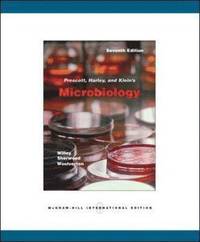
- Format
- Häftad (Paperback / softback)
- Språk
- Engelska
- Utgivningsdatum
- 2007-02-01
- Upplaga
- 7 Revised edition
- Förlag
- McGraw Hill Higher Education
- Illustrationer
- Illustrations
- Dimensioner
- 280 x 230 x 35 mm
- Vikt
- ISBN
- 9780071102315
- 2565 g
Kundrecensioner
Övrig information
Lansing Prescott served as Professor of Biology and chair of the department at Augustana College in Sioux Falls, South Dakota, until May 1999. Dr. Prescott received his B.A. and M.A. in biology from Rice University and his Ph.D. in biochemistry from Brandeis University. He was a visiting lecturer at the University of Georgia in 1980. In 1989, he received a faculty achievement award for excellence in teaching. John Harley is a professor at Eastern Kentucky University. He received his B.A. degree in biology and chemistry from Youngstown State University in 1964, an M.A. degree in parasitology and microbiology from Kent State University in 1966, and his Ph.D. in cardiovascular physiology from Kent State University in 1969. Dr. Harley did postdoctoral work at Baylor College of Medicine, Argonne National Lab, and Vanderbilt University. In 1972 he accepted a faculty position at Eastern Kentucky University, where he rose through the ranks to full professor and in 1990 was named a Foundation Professor by the EKU Alumni Association and Board of Reagents. He also holds full graduate status at the University of Kentucky where he teaches a pathophysiology course in the graduate program. Donald Klein is a Professor of Microbiology at Colorado State University, Fort Collins, Colorado. Dr. Klein received his B.S. and M.S. degrees in agriculture and agricultural microbiology from the University of Vermont. After predoctoral studies at the University of Tubingen, Germany, he received his Ph.D. in microbiology from the Pennsylvania State University.
Innehållsförteckning
Part I: Introduction to Microbiology Ch. 1: The History and Scope of Microbiology Ch. 2: The Study of Microbial Structure: Microscopy and Specimen Preparation Ch. 3: Procaryotic Cell Structure and Function Ch. 4: Eucaryotic Cell Structure and Function Part II: Microbial Nutrition, Growth, and Control Ch. 5: Microbial Nutrition Ch. 6: Microbial Growth Ch. 7: Control of Microorganisms by Physical and Chemical Agents Part III: Microbial Metabolism Ch. 8: Metabolism: Energy, Enzymes, and Regulation Ch. 9: Metabolism: Energy Release and Conservation Ch. 10: Metabolism: The Use of Energy in Biosynthesis Part IV: Microbial Molecular Biology and Genetics Ch. 11: Microbial Genetics: Gene Structure, Regulation, and Expression Ch. 12: Microbial Genetics: Regulation of Gene Expression Ch. 13: Microbial Genetics: Mechanisms of Genetic Variation Part V: DNA Technology and Genomics Ch. 14: Recombinant DNA Technology Ch. 15: Microbial Genomics Part VI: The Viruses Ch. 16: The Viruses: Introduction and General Characteristics Ch. 17: The Viruses: Viruses of Bacteria and Archaea Ch. 18: The Viruses: Eucaryotic Viruses and Other Acellular Infectious Agents Part VII: The Diversity of the Microbial World Ch. 19: Microbial Evolution, Taxonomy, and Diversity Ch. 20: The Archaea Ch. 21: Bacteria: The Deinococci and Nonproteobacteria Gram Negatives Ch. 22: Bacteria: The Proteobacteria Ch. 23: Bacteria: The Low G + C Gram Positives Ch. 24: Bacteria: The High G + C Gram Positives Ch. 25: The Protists Ch. 26: The Fungi (Eumycota) Part VIII: Ecology and Symbiosis Ch. 27: Biogeochemical Cycling & Introductory Microbial Ecology Ch. 28: Microorganisms in Marine and Fresh Water Environments Ch. 29: Microorganisms in Terrestrial Environments Ch. 30: Microbial Interactions Part IX: Interaction Between Human Host and Pathogenic Microbes Ch. 31: Nonspecific (Innate) Host Resistance Ch. 32: Specific (Adaptive) Immunity Ch. 33: Pathogenicity of Microorganisms Part X: Agents of Infectious Disease and Their Control Ch. 34: Antimicrobial Chemotherapy Ch. 35: Clinical Microbiology and Immunology Ch. 36: The Epidemiology of Infectious Disease Ch. 37: Human Diseases Caused by Viruses and Prions Ch. 38: Human Diseases Caused by Bacteria Ch. 39: Human Diseases Caused by Fungi and Protists Part XI: Food and Industrial Microbiology Ch. 40: Microbiology of Food Ch. 41: Applied and Industrial Microbiology
